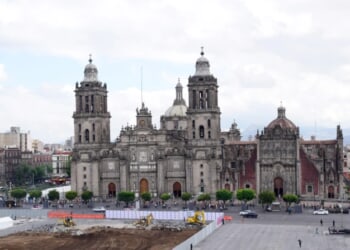A decentralized, solar-powered energy cloud of wireless charging and shared storage should be the next internet-scale infrastructure in the United States.
Power systems are being asked to do what they were never designed to do: balancing variable solar and wind, electrifying transport, and serving a world of mobile devices and data-center demand. Simply adding more wires and central power plants will not deliver the flexibility this century requires. A new architecture is needed—an energy cloud—that treats electricity less like a one-way commodity and more like a networked service available anywhere, on demand.
How An Energy Cloud Works
The energy cloud fuses two ideas. First, ubiquitous wireless charging hubs—embedded in curbs, parking bays, transit stops, sidewalks, buildings, and even street furniture—so that phones, wearables, scooters, and electric vehicles (EVs) top up by proximity rather than by plug. Second, a decentralized web of storage—from home batteries, commercial packs, community microgrids, and parked EVs with bidirectional capability—coordinated by software to absorb sunshine at midday and supply neighborhoods at night. Devices become not just loads but nodes.
Technically, most pieces already exist. Inductive charging has matured from phones to pilot projects for EVs in parking stalls and controlled road segments. Bidirectional vehicle-to-grid (V2G) inverters are moving from labs into fleets. Virtual power plants (VPPs) have linked thousands of rooftop solar homes to stabilize grids. What is missing is the unifying platform: common standards and market rules that let any charger, battery, or car participate in a secure, automated marketplace for electrons—much as the internet allowed any server to trade data packets.
The uniqueness of the energy-cloud approach is not merely “more chargers” or “more batteries.” It is the seamless mesh. Phones and wearables trickle-charge from low-power transmitters; scooters and delivery robots charge opportunistically; EVs quietly sip or supply power while parked; buildings arbitrage time-of-use prices; neighborhoods island during outages; all coordinated by software that values flexibility and proximity. In practical terms, it is Wi-Fi for power.
Policy and Social Impact
Policy and social impact are paramount. An energy cloud model democratizes energy by enabling communities to host and co-own local hardware, earning revenue from providing capacity, resiliency, and grid services. Energy-as-a-service financing can remove upfront costs for small businesses, schools, and multi-family housing, accelerating deployment where it matters most. Clear interconnection rules, standardized cybersecurity, and consumer protections can unlock peer-to-peer trading while preserving safety and fairness.
Claims about declining support for clean-energy research and development (R&D) and incentives in recent years are less important than the solution: reliable rules of the road. Policymakers should focus on four no-regret moves: (1) bidirectional-charging standards across automakers and utilities; (2) open, auditable settlement for distributed energy markets so participants get paid quickly; (3) streamlined local permitting for curbside and off-street inductive pads; and (4) resilience credits for microgrids and building-level storage that keep critical loads powered during outages.
Business Model and Early Pilots
On the business side, the model mirrors successful platform plays. Hosts (retailers, churches, clinics, parking operators, campuses, and homeowner associations [HOAs]) provide space and gain a share of charging and grid-service revenues. Integrators finance hardware and software, aggregating thousands of sites into a dispatchable portfolio. Automakers capture loyalty by bundling “cloud miles” with EVs, just as phone carriers once bundled minutes. Cities designate Energy Cloud Zones near transit and dense housing, linking local resilience goals to economic development.
Global pilots point the way. Wireless EV pads in controlled sites are reducing driver friction. VPPs in several countries have shown that distributed solar-plus-storage can shave peaks and lower bills. Dynamic pricing has nudged EV charging into surplus-renewable hours. The frontier is stitching this into a unified, secure fabric where any node can buy, sell, or lend power automatically-with strong privacy and consumer choice baked in.
Risks and Opportunities
Critics worry about efficiency losses in wireless transfer and about cybersecurity. Both deserve serious attention-and manageable mitigation. Inductive systems are improving rapidly, and most wireless energy in the cloud would be “opportunistic top-ups,” not long-haul power flows. Cyber risk can be contained with layered authentication, hardware roots of trust, and fail-safe local control. The greater social risk is clinging to a brittle, centralized model that under-utilizes abundant rooftop and roadside sunshine and strands terawatt-hours in parked vehicles.
The opportunity is to turn mobility and proximity into assets. A city block with ten EVs becomes a small power plant at 6 p.m. A school’s parking lot helps balance the local feeder after dismissal. Delivery depots act as buffers against heat-wave peaks. Phones, scooters, and wearables charge invisibly throughout the day, reducing evening spikes. When outages strike, microgrids island in place while the broader network reconfigures around them. This is not science fiction; it is software and standards.
Lessons from History
History is a guide. The internet did not win because dial-up modems were perfect; it won because open protocols and distributed design unlocked innovation at the edge. The energy cloud is the same wager: that smarter coordination of many small assets can outperform the brute force of a few giant ones—and do so with cleaner air, greater resilience, and broader participation.
If the objective is to electrify everything while keeping societies reliable and free, then power must become ambient, not scarce; local, not distant; flexible, not fixed. Building an energy cloud—wireless where convenient, decentralized everywhere, and governed by open markets—can make electricity feel as effortless as Wi-Fi. With the pieces already in hand, the question is no longer a technological possibility but a collective will.
About the Author: Dinesh S. Sastry
Dinesh S. Sastry is Founder & President of Illuminant Capital Holdings LLC, based in San Francisco. He studied electrical engineering and computer science at UC Berkeley during the early AI era, earned a J.D. at Georgetown Law focused on corporate and campaign finance, and served as a DNC and DSCC trustee. Dinesh also hosted fundraisers with President Clinton, Vice President Gore, and Majority Leader Tom Daschle, and served on the Biden–Harris finance committees.
Image: Kanr2425/shutterstock
















